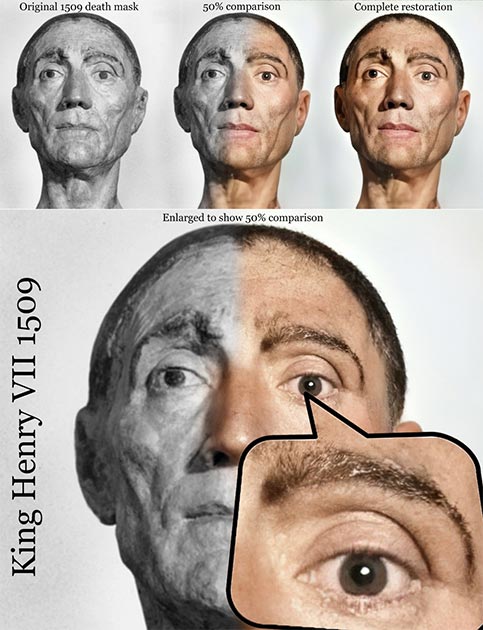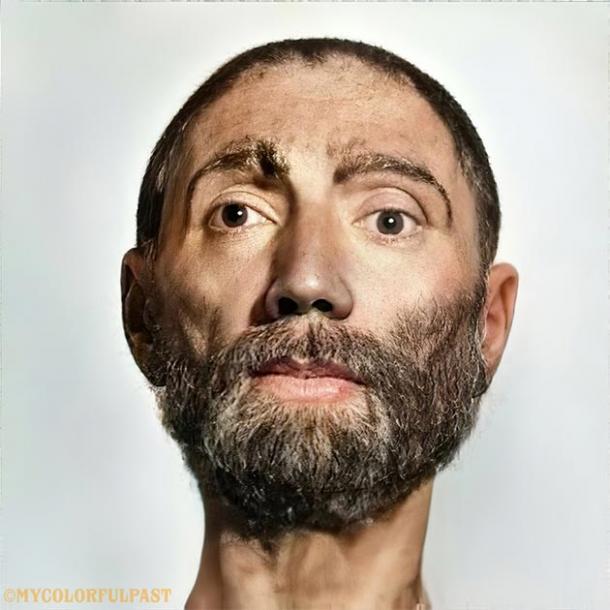
Look History in the Eye! King Henry VII Reconstructed from Death Mask
An Irish artist has brought King Henry VII of England back to life in a high-tech historical photography project. Looking deeply into the photo-realistic eyes of the famous English king, the observer’s mind is free to wander into the historical world of the legendary warrior-king, who with what is recorded as an “embarrassingly slender” claim to the throne, took it by sheer force and determination and went on to change the entire socio-political landscape of England.
One of the most turbulent, therefore the most dramatized, periods of English history was during the Tudor monarchy of the late 15 th and 16 th centuries, and perhaps most remembered are figures such as Elizabeth and Henry VIII, not to mention his harem of wives, but less talked about is the founder of the dynasty, his father, Henry Tudor, who became King Henry VII of England.
As a 14-year-old boy, Henry became the strongest Lancastrian claimant to the English throne, even though Historians say his claim was exceptionally weak, and as such he fled England to the relative safety of Burgundy in France. During his time in exile, the Wars of the Roses raged in England between supporters of the child king to be, and armies of the Yorkist Edward IV.

A young Henry VII (Public Domain)
In 1485, Henry set sail from Burgundy to his homeland of Wales where he joined his army who had landed at Mill Bay on the Pembrokeshire coast on 7 th August. They marched inland gathering support as they closed upon London and on 22nd August 1485 AD, at Bosworth, a small market town in Leicestershire, Henry defeated an army of rival forces and was crowned Henry VII of England, after his victory on the battlefield he immediately marched for London to sit upon his throne, where he would remain for 24 years.
Henry died of tuberculosis on 21 April 1509 AD. His death mask, from which Matt’s reconstruction was made, was produced to form part of the funeral effigy which would have lain on top of Henry’s casket when it was transported to Westminster Abbey in London for burial. Unsurprisingly, Henry’s death mask shows him as gaunt and ill-looking.
Photographing Lowly Cowboys, Warrior Kings and Ancient Egyptian Royalty
Matt Loughrey is a 41-year-old graphic artist living in Ireland who runs a creative studio and the website mycolorfulpast.com, which says it is “bridging a gap between history and art” using digital editing technology to recreate historical figures.

Stages of restoration to King Henry VII death mask. (Courtesy of Matt Loughrey / My Colorful Past)
In an exclusive interview with Ancient Origins, Matt said that in 2014 he began looking at how to “repurpose historical photography using colorization, and he began programming and familiarizing himself with new techniques. Matt said the main obstacle was locating “realism and therein relatability,” however, after five years, his work caught the attention of a writer at National Geographic and My Colorful Past became reality with the collection currently being featured in American schools, as well as across museums and libraries the world over.
Among the artist’s recreations are historical giants like Mary Queen of Scots, Billy the Kid and Jessie James, but in the spectacular collection is the bust of King Henry VII of England, who looks almost like a Roman emperor with an elongated Roman nose, tilted upwards, perhaps ‘over’ the people of England. And it was after recreating the face of King Henry VII that the artist felt confident enough to trace back further in time and give attention to the faces of royal Egyptian mummies.
- Bloody Mary: Tumultuous Beginnings for a Future Queen of England
- Forensic Facial Reconstruction: The Journey to Connect with our Ancestors
- Facing the Facts: Just How Accurate Are Facial Reconstructions?

Left: Restoration and color work in progress to the 3,307-year-old mummified face of pharaoh Menmaatre Seti I. Right: Close up of bringing to life the 3,345-year-old face of Tutahkhamun. (Courtesy of Matt Loughrey / My Colorful Past)
In the world of professional historical recreations there is a faction of specialists, generally jealous of artists such as Matt, who might argue that facial colorings and hair patterns are all subjective, and that maybe King Henry VII had a mustache or a beard. However, Matt has all this covered and the process of applying different skin colorings, hair styles or facial hair is but the press of a button away as everything is built on individual layers, which can be switched on or off on demand.

Artist Matt Loughrey’s reconstruction of the bust of King Henry VII of England. Death & life masks require clear skin in order for the wax layer to be formed. (Courtesy of Matt Loughrey / My Colorful Past)
A Golden Opportunity for Reinterpreting Historic Archives
According to Historic England, Historians remember King Henry VII for his “somber nature,” which the artist has near-perfectly captured in his recreation, and if you think all this is impressive, Matt explained that this is really only the beginning of such imagery in terms of documentary production and exhibits, because with 8K around the corner it is time to look towards historic archives, for this new technology presents “an opportunity to enhance assets.’
Top image: Left: artist Matt Loughrey’s reconstruction of the bust of King Henry VII of England. (Courtesy of Matt Loughrey / My Colorful Past). Right: Henry Tudor, painted on 29 October 1505 AD by Herman Rinck, an agent for the Holy Roman Emperor, Maximilian I. (National Portrait Gallery / Public domain)















